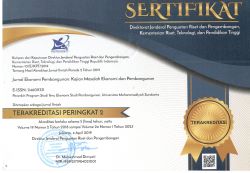Technical Inefficiency in Nine Clusters of Indonesian Manufacturing Firms And its Determinants: Stochastic Frontier Analysis
Theresya Jeini Astanto(1), Suyanto - Suyanto(2*), Henrycus Winarto Santoso(3), Ruhul Salim(4)(1) Faculty of Business and Economics, Universitas Surabaya
(2) Faculty of Business and Economics, Universitas Surabaya
(3) Faculty of Business and Economics, Universitas Surabaya
(4) School of Accounting, Economics and Finance, Curtin University, Australia
(*) Corresponding Author
Abstract
Keywords
Full Text:
PDFReferences
Aggrey, N., Eliab, L., & Joseph, S. (2010). The Relationship between Firm Size and Technical Efficiency in East Africa Manufacturing Firms. Journal of Sustainable Development in Africa, 12(4), 226-236.
Ai, H., Wu, X., & Li, K. (2019). Differentiated Effects of Diversified Technological Sources on China's Electricity Consumption: Evidence from the Perspective of Rebound Effect. Energy Policy, 1-8. DOI: 10.1061/j.enpol.2019.11184
Bas, M. (2012). Input-Trade Liberalization and Firm Export Decisions: Evidence from Argentina. Journal of Development Economics, 97, 481-493.
Bogetoft, P., & Otto, L. (2011). Benchmarking with DEA, SFA, and R. International Series in Operations Research & Management Science, 10.1007/978-1-4419-7961-2_7.
Coelli, T. J., & Battese, G. (1995). A Model for Technical Inefficiency Effects in a Stochastic Frontier Production Function for Panel Data. Empirical Economics, 20(2), 325-332. DOI: 10.1007/BF01205442
Coelli, T. J., Rao, D. P., & Battese, G. E. (2005). An Introduction to Efficiency and Productivity Analysis (2nd ed.). United States: Springer.
Esquivias, M. A., & Harianto, S. K. (2020). Does Competition and Foreign Investment Spur Industrial Efficiency? Firm-Level Evidence from Indonesia. Heliyon, 6, 1-10. DOI: 10.1016/j.heliyon.2020.e04494
Farrell, M. J. (1957). The Measurement of Productive Efficiency. Journal of the Royal Statistical Society, 253-290.
Fukuyama, H., Matousek, R., & Tzeremes, N. G. (2020). A Nerlovian Cost Inefficiency Two-stage DEA Model for Modeling Banks' Production Process: Evidence from The Turkish Banking. Omega 95, 1-13. DOI: https://doi.org/10.1016/j.omega.2020.102198
Gutierrez, E., & Teshima, K. (2017). Abatement Expenditures, Technology Choice, and Environmental Performance: Evidence from Firm Responses to Import Competition in Mexico. Journal of Development Economics.
He, L.-Y., & Huang, G. (2021). How Can Export Improve Firms’ Energy Efficiency? The Role of Innovation Investment. Structural Change and Economic Dynamics, 59, 90-97.
Hossain, M. M., & Majumder, K. A. (2015). On Measurement of Efficiency of Cobb-Douglas Production Function with Additive and Multiplicative Errors. Statistics, Optimization and Information Computing, 3, 96-104.
Ikhsan, M. (2007). Total Factor Productivity Growth in Indonesian Manufacturing: A Stochastic Frontier Approach. Global Economic Review, 36(4), 321-342. DOI: 10.1080/12265080701694488
Imbruno, M., & Ketterer, T. D. (2018). Energy Efficiency Gains from Importing Intermediate Inputs: Firm-Level Evidence from Indonesia. Journal of Development Economics, 1-63. DOI: 10.1016/j.jdeveco.2018.06.014
Kumbhakar, S. C. (2013). Specification and Estimation of Multiple Output Technologies: A Primal Approach. European Journal of Operational Research, 231, 465-473.
Lafuente, E., Leiva, J. C., Gomez, J. M., & Szerb, L. (2020). A Nonparametric Analysis of Competitiveness Efficiency: The Relevance of Firm Size and the Configuration of Competitive Pillars. Business Research Quarterly, 23(3), 203-216. DOI: 10.1177/2340944420941440
Lemi, A., & Wright, I. (2018). Exports, Foreign Ownership, and Firm-Level Efficiency in Ethiopia and Kenya: An Application of the Stochastic Frontier Model. Empirical Economics, 1-30. DOI: 10.1007/s00191-018-1521-9
Lestari, E. P., & Isnina, W.S.U. (2017). Analisis Kinerja Industri Manufaktur di Indonesia. Journal of Research in Economics and Management, 17(1), 183-198. DOI: 10.17970/jrem.17.1701013.ID
Liu, Y. (2018). Government Extraction and Firm Size: Local Officials' Responses to Fiscal Distress in China. Journal of Comparative Economics, 46(6), 1310-1331. DOI: 10/1016/j/jce.2018.09.002
Margono, H., & Sharma, S. C. (2006). Efficiency and Productivity Analysis of Indonesian Manufacturing Industries. Journal of Asian Economics, 17(6), 979-995.
Musau, A., Kumbhakar, S. C., Mydland, O., & Lien, G. (2020). Determinants of Allocative and Technical Inefficiency in Stochastic Frontier Models: An Analysis of Norwegian Electricity Distribution Firms. European Journal of Operational Research, 1-30. DOI: https://doi.org/10.1016/j.ejor.2020.06.023
Octrina, F., & Mariam, A. G. (2021). Islamic Bank Efficiency in Indonesia: Stochastic Frontier Analysis. Journal of Asian Finance, Economics and Business, 8(1), 751-758. DOI: 10.13106/jafwb.2021.vol8.no1.751
Perusic, N. B., & Zhang, J. H. (2019). Import Effect on Technical Efficiency of Cargo Ports: Evidence from Italy, Slovenia, and Croatia. Journal of Economics and Sustainable Development, 10(22), 152-159. DOI: 10.7176/JESD/10-22-16
Priya, R. S., & Aroulmoji, V. (2020). A Review on Productivity and its Effect in Industrial Manufacturing. International Journal of Advanced Science and Engineering, 6(4), 1490-1499.
Roy, J., & Yasar, M. (2015). Energy Efficiency and Exporting: Evidence from Firm-Level Data. Energy Economics, 52, 127-135.
Sahoo, B. K., & Nauriyal, D. K. (2014). Trends in and Determinants of Technical Efficiency of Software Companies in India. Journal of Policy Modeling, 1-23. DOI: http://dx.doi.org/10.1016/j.jpolmod.2013.12.001
Sari, D. W., Khalifah, N. A., & Suyanto, S. (2016). The Spillover Effects of Foreign Direct Investment on Productivity Performances. J Prod Anal, 199-233. DOI: 10.1007/s11123-016-0484-0
Setiawan, M., Effendi, N., Heliati, R., Syahrin, A., & Waskito, A. (2019). Technical Efficiency and its Determinants in the Indonesian Micro and Small Enterprises. Journal of Economic Studies, 46(6), 1157-1173. DOI: 10.1108/JES-08-2018-0298
Setiawan, M., Emvalomatis, G., & Lansink, A. O. (2012). The Relationship between Technical Efficiency and Industrial Concentration: Evidence from the Indonesian Food and Beverages Industry. Journal of Asian Economics, 23, 466-475. DOI: 10.1016/j.asieco.2012.01.002
Setiawan, M., Indiastuti, R., Hidayat, A. K., & Rostiana, E. (2021). R&D and Industrial Concentration in the Indonesian Manufacturing Industry. Journal of Open Innovation, Technology, Market, and Complexity, 7(112), 1-12. DOI: 10.3390/joitmc7020112
Strydom, H. (2013). An Evaluation of the Purposes of Research in Social Work. Social Work, 49(2), 149-164. DOI: 10.15270/49-2-58
Sharma, C. (2017). Exporting, Access of Foreign Technology, and Firms’ Performance: Searching the Link in Indian Manufacturing. The Quarterly Review of Economics and Finance. DOI: https://doi.org/10.1016/j.qref.2017.11.015
Suyanto, S., Salim, R., & Bloch, H. (2014). Which Firms Benefit from Foreign Direct Investment? Empirical Evidence from Indonesian Manufacturing. Journal of Asian Economics , 33, 16-29
Suyanto, & Sugiarti, Y. (2018). Do Local Suppliers and Local Buyers Benefit from Foreign Direct Investment: Evidence from Indonesia. Advances in Social Science, Education and Humanities Research (ASSEHR), 186, 220-223.
Suyanto, S., Sugiarti, Y., & Setyaningrum, I. (2021). Clustering and Firm Productivity Spillovers in Indonesian Manufacturing. Heliyon, 7, 1-10. DOI: https://doi.org/10.1016/j.heliyon.2021.e06504
Suyanto, S., Sugiarti, Y., & Tanaya, O. (2020). Inefficiency of Indonesian Food and Beverages Firms. ICEBE, 1-7. DOI: 10.4108/eai.1-10-2020.2304707
Suyanto, S., Sugiarti, Y., & Tanaya, O. (2021). Technological Progress in Indonesian Food Processing. Advances in Economics, Business and Management Research, 180, 92-97.
Tingum, E. N., & Ofeh, M. A. (2017). Technical Efficiency of Manufacturing Firms in Cameroon: Sources and Determinants. International Journal of Financial Research, 8(3), 172-186. DOI: 10.5430/ijfr.v8n3p172
Tsionas, M. G. (2020). Quantile Stochastic Frontiers. European Journal of Operational Research, 1-16. DOI: 10.1016/j.ejor.2019.10.012
Turnbull, C., Sun, S., & Anwar, S. (2016). Trade Liberalization, Inward FDI and Productivity within Australia’s Manufacturing Sector. Economic Analysis and Policy, 50, 41-51.
Walujadi, D. (2004). Age, export orientation and technical efficiency: Evidence from garment firms in DKI Jakarta. Makara, Sosial Humaniora, 8(3), 97-104.
Zhu, J., Wang, Y., & Wang, C. (2018). A Comparative Study of the Effects of Different Factors and Firm Technological Innovation Performance in Different High-Tech Industries. Chinese Management Studies. DOI: 10.1108/SMS-10-2017-0287
Article Metrics
Abstract view(s): 351 time(s)PDF: 282 time(s)
Refbacks
- There are currently no refbacks.
















